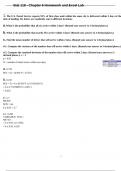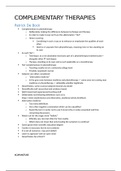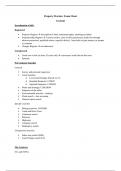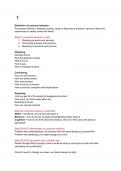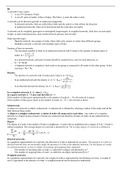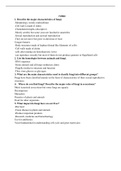CH1 The strategic management beast
There are ten schools, listed below:
The design school Strategy formation as a process of conception (1960)
The planning school Strategy formation as a formal process (1960)
The positioning school Strategy formation as an analytical process (1970)
The entrepreneurial school Strategy formation as a visionary process
The cognitive school Strategy formation as a mental process
The learning school Strategy formation as an emergent process
The power school Strategy formation as a process of negotiation
The cultural school Strategy formation as a collective process
The environmental school Strategy formation as a reactive process
The configuration school Strategy formation as a process of transformation
The first three schools are prescriptive in nature - more concerned with how strategies should be
formulated than with how they necessarily do form. The six schools that follow consider specific
aspects of the process of strategy formation. They have been concerned less with prescribing ideal
strategic behavior than with describing how strategies do, in fact, get made. Each of the four schools
that follows has tried to open up the process of strategy formation beyond the individual, to other
forces and other actors. Finally, is one school which it could be argued really combines the others.
We call it configuration.
Five Ps for strategy
• Strategies as plans and patterns (The planning school, the positioning school)
Organizations develop plans for their future and they also evolve patterns out of their past. We
can call one intended strategy and the other realized strategy. Intentions that are fully realized
can be called deliberate strategies. Those that are not realized at all can be called unrealized
strategies. There is a third case, which we call emergent strategy - where a pattern is realized
that was not expressly intended. Strategies have to form as well as be formulated. An umbrella
strategy means that the broad outlines are deliberate, while the details are allowed to emerge
en route.
• Strategies as positions and perspective (The positioning school, entrepreneurial school)
As position, strategy looks down to the spot where the product meets the customer, as well as
out - to the external marketplace. As perspective, in contrast, strategy looks in - inside the
organization, but also looks up - to the grand vision of the enterprise.
• Strategy is a ploy (The power school)
A specific 'manoeuvre' intended to outwit an opponent or competitor. Here the real strategy is
the threat, not the act, and such is a ploy.
,CH2 The design school
At its simplest, the design school proposes a model of strategy making that seeks to attain a match,
or fit, between internal capabilities and external possibilities.
Origins of the design school
The first books in this field were; leadership in administration (Selznick), strategy and structure
(Chandler) and business policy: text and cases (Andrews).
The basic design school model
,With the notable exception of Selznick (1957), however, most authors associated with this school do
not accord a great deal of attention to values and ethics.
Richard Rumelt (1997) provided the best framework for making the evaluation for choosing a
strategy in terms of a series of tests:
• Consistency
• Consonance (the strategy must represent an adaptive response to the external environment
and to the critical changes occurring within it.
• Advantage
• Feasibility (the strategy must neither overtax available resources nor create unsolvable
subproblems)
Premises of the design school
• Strategy formation should be a deliberate process of conscious thought
• Responsibility for that control and consciousness must rest with the chief executive officer:
that person is the strategist
• The model of strategy formation must be kept simple and informal
• Strategies should be one of a kind: the best ones result from a process of individualized design
• The design process is complete when strategy appears fully formulated, as perspective
• These strategies should be explicit, so they have to be kept simple
• Only after these unique, full-blown, explicit, and simple strategies are fully formulated can they
then be implemented
Critique of the design school
, The premises of the model deny certain important aspects of strategy formation, including
incremental development and emergent strategy, the influence of existing structure on strategy, and
the full participation of actors other than the chief executive.
Assessment of strengths and weaknesses: bypassing learning
This school promotes strategy formation as a process of conception rather than as one of learning.
Structure follows strategy ... as the left foot follows the right
Strategy formation is an integrated system, not an arbitrary sequence
Making strategy explicit: promoting inflexibility
Separation of formulation from implementation: detaching thinking from acting
The design school: contexts and distributions
We see a set of four conditions in particular that should encourage an organization to tilt toward the
design school model:
• One brain can, in principle, handle all of the information relevant for strategy formation
• That brain is able to have full, detailed, intimate knowledge of the situation in question
• The relevant knowledge must be established before a new intended strategy has to be
implemented
• The organization in question must be prepared to cope with a centrally articulated strategy
Above all is the organization that needs a major reorientation, a period of reconception of its
strategy, at least under two conditions. First, there has to have been a major change in the situation,
so that the existing strategy has been seriously undermined. And second, there has to have
developed the beginnings of a new stability, one that will support a new conception of strategy.
There is another context where the design school model might apply, and that is the new
organization, since it must have a clear sense of direction in order to compete with its more
established rivals.
CH3 The planning school
In fact, the planning school originated at the same time as the design school; its most influential
book, Corporate Strategy, by H. Igor Ansoff was, like that of the Harvard group, published in 1965.
Hardly any research was undertaken to find out how planning really worked in practice.
The basic strategic planning model
Most reduce to the same basic ideas: take the SWOT model, divide it into neatly delineated steps,
articulate each of these with lots of checklists and techniques, and giving special attention to the
setting of objectives on the front end and the elaboration of budgets and operating plans on the back
end.




